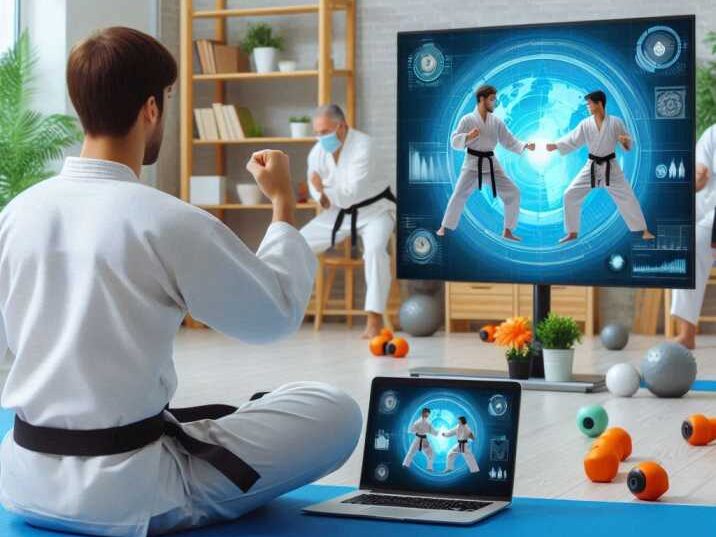Introduction
Table of Contents
Mixed Martial Arts (MMA) is a popular sport that combines techniques from various martial arts, such as boxing, wrestling, jiu-jitsu, and karate. Learning MMA can help build strength, agility, and discipline, and it’s a great way to stay active. You don’t need a fancy gym or expensive equipment to get started; with some dedication, you can learn MMA right at home. This guide will provide you with tips and techniques to help you begin your MMA journey from the comfort of your home.

Why Learn Mixed Martial Arts at Home?
Learning Mixed Martial Arts at home can be a fun and convenient way to stay fit and develop self-defense skills. It requires concentration and discipline, which can help improve your focus in school and other activities. Here are a few reasons why learning MMA at home might be a great idea:
- Convenience: Learning Mixed Martial Arts at home allows you to train whenever it fits into your schedule, eliminating the need for travel to a gym. You can practice early in the morning, late at night, or whenever you have free time, making it flexible and easy to fit into a busy lifestyle.
- Affordability: Mixed Martial Arts Training at home can save you money on gym memberships and expensive equipment. You can start with minimal gear, like gloves and mats, and gradually invest in more equipment as you advance, making it a cost-effective way to learn MMA.
- Personalized Learning: Learning Mixed Martial Arts At home, you have the freedom to focus on the techniques and skills that interest you most. Whether you want to improve your striking, grappling, or overall fitness, you can tailor your training sessions to your specific goals and progress at your own pace.
Getting Started with MMA Training at Home
Before starting your Mixed Martial Arts training at home, it’s important to ensure a safe and suitable environment. Here are some steps to help you get started:
1. Create a Safe Training Space
Clear an area in your home where you can move freely without bumping into furniture or other objects. Ensure the space is free from any hazards that could cause accidents. A non-slippery floor is crucial to avoid falls and ensure a safe practice environment.
Choosing the Right Surface: Training on a hard surface can be risky and lead to injuries. If possible, use a soft mat or thick carpet to cushion any falls. This will help protect your joints and prevent injuries during intense training sessions, making your practice safer and more effective.
2. Start with Basic Warm-Ups and Stretching
Warming up is essential before beginning any martial arts practice to reduce the risk of injuries. Start with light cardio exercises such as jumping jacks, running in place, or skipping rope to increase your heart rate and get your blood flowing. Follow this with dynamic stretches that target your arms, legs, and core muscles to improve flexibility and prepare your body for more strenuous movements.
Warm-Up Exercises to Try:
- Jumping Jacks: Perform 2 sets of 30 seconds to increase your heart rate and warm up your muscles.
- High Knees: Perform 2 sets of 30 seconds to work on your cardiovascular fitness and leg strength.
- Arm Circles: Perform 2 sets of 15 seconds in each direction to loosen up your shoulders and upper body.
- Leg Swings: Perform 2 sets of 10 swings per leg to warm up your hip flexors and legs.
3. Practice Striking Techniques
Striking is a fundamental part of MMA and includes techniques from martial arts like boxing and Muay Thai. Focusing on basic strikes will help build your offensive skills and improve your overall technique. Practicing regularly will enhance your coordination, speed, and power.
Basic Striking Techniques to Learn:
- Jab:
- A quick, straight punch thrown with the lead hand. It’s great for maintaining distance and setting up more powerful strikes. The jab is fundamental in boxing and MMA for controlling the pace of the fight and keeping the opponent at bay.
- Cross:
- A powerful punch thrown with the rear hand. It involves rotating the body to generate force and is used for delivering a strong, straight punch to an opponent. This strike can be highly effective in disrupting an opponent’s rhythm and creating openings for further attacks.
- Hooks:
- Curved punches aimed at the sides of an opponent’s head or body. Hooks are powerful and can catch an opponent off-guard, especially when aimed at their jaw or ribs. Practicing hooks can improve your ability to land significant blows in close-range combat.
- Kicks:
- Practice basic kicks like front kicks and roundhouse kicks. Focus on proper form, balance, and accuracy. Kicking techniques from martial arts like Muay Thai add versatility to your striking game and are essential for attacking both the upper and lower body of an opponent.
Focus on Grappling and Ground Techniques
Grappling
is a crucial component of MMA, involving techniques from wrestling and Brazilian jiu-jitsu. Practicing grappling drills can be done with a partner or using a grappling dummy. Start with basic takedowns like the single-leg and double-leg takedowns to learn how to bring an opponent to the ground effectively. Work on different guard positions, such as closed guard, open guard, and half guard, to improve your control and defense when on the ground. Additionally, practice simple submission techniques like the rear-naked choke and armbar, which are essential for finishing a fight when grappling.
Staying Motivated While Training at Home
Maintaining motivation while training at home can be tough, especially if you’re new to MMA. However, staying motivated is key to consistent progress. Here are some tips to help you stay on track:
Set Clear Goals
Setting specific, measurable, achievable, relevant, and time-bound (SMART) goals can help keep you focused and motivated during your MMA training. For instance, set small, achievable targets such as mastering a particular strike or improving your cardio endurance. These goals give you something tangible to work towards and provide a sense of accomplishment as you achieve them.
Examples of SMART Goals for MMA Training:
- “I will practice my jab and cross punches for 15 minutes every day for two weeks.”
- “I will run for 10 minutes before each training session to improve my endurance.”
Follow Online Tutorials and Classes
Taking advantage of the many online resources available can significantly enhance your MMA training at home. Look for beginner-friendly tutorials that break down techniques step-by-step, making them easy to follow. Online platforms like YouTube offer numerous channels focused on MMA training for beginners, providing visual demonstrations and detailed explanations. Additionally, consider enrolling in online martial arts classes with certified instructors or using MMA training apps that provide structured workout plans.
Recommended Online Resources:
- YouTube channels focused on MMA training for beginners.
- Online martial arts classes with certified instructors.
- MMA training apps with structured workout plans.

Improving Your MMA Skills Over Time
As you progress with your MMA training at home, it’s important to track your development and gradually increase the intensity of your workouts.
Regularly Evaluate Your Progress
Keeping a training journal is a great way to note improvements and identify areas that need more work. Regular self-evaluation helps you stay on track and see how far you’ve come. You can record videos of your techniques to analyze your form and make necessary adjustments. Writing down the number of repetitions or the duration of each drill can help you monitor your physical conditioning and endurance. Reflecting on what you find challenging and seeking additional resources to address those challenges will ensure continuous improvement in your MMA skills.
Tips for Tracking Progress:
- Record videos of your techniques to analyze form and improve.
- Write down the number of repetitions or duration of each drill.
- Reflect on what you find challenging and seek additional resources to help.
Table: Basic MMA Techniques for Beginners
| Technique | Description | Martial Art Origin |
|---|---|---|
| Jab | Quick, straight punch with the lead hand | Boxing |
| Cross | Powerful, straight punch with the rear hand | Boxing |
| Front Kick | A straight kick aimed at the opponent’s torso | Muay Thai, Karate |
| Roundhouse Kick | A circular kick with the rear leg aimed at the opponent’s head or body | Muay Thai |
| Armbar | Joint lock targeting the elbow joint | Brazilian Jiu-Jitsu |
| Rear-Naked Choke | Submission hold applied from behind the opponent | Brazilian Jiu-Jitsu |
Conclusion
Learning mixed martial arts at home is a fantastic way to stay fit, learn self-defense, and improve discipline and focus. With the right space, equipment, and resources, you can practice and master MMA techniques in the comfort of your own home. Remember to stay motivated, set clear goals, and continuously assess your progress. As you build your skills and confidence, you’ll find that the benefits of MMA training extend far beyond physical fitness—they also help build mental resilience and focus.
FAQs
1. Can you learn mixed martial arts at home without any equipment?
Yes, you can start with basic exercises and techniques that don’t require any equipment. However, some equipment, like a punching bag or training dummy, can be helpful for practicing specific techniques.
2. What are the basic MMA techniques for beginners?
Beginners should start with basic striking techniques like jabs, crosses, hooks, and basic kicks, as well as grappling techniques like takedowns and submissions.
3. How much time should I dedicate to MMA training at home?
Start with short sessions of 15-30 minutes and gradually increase as you build your stamina and skills. Consistency is more important than duration.
4. Do I need a partner to practice mixed martial arts at home?
While a partner can be beneficial for practicing grappling techniques, many MMA skills, such as striking and conditioning, can be practiced alone.
5. How can I stay motivated to learn mixed martial arts at home?
Setting clear goals, following online tutorials, tracking your progress, and maintaining a consistent training schedule can help keep you motivated.


